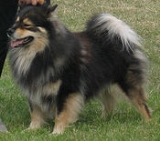
Finnish Lapphund
Encyclopedia
The Finnish Lapphund is a hardy, easy going, medium-size breed
of Spitz
type. Traditionally it has been used for herding reindeer
. Although it is one of the most popular dog breeds in its native country, Finland
, it is not very numerous outside of the Nordic countries
.
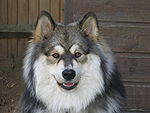
. It has a profuse coat with pricked, highly mobile ears.
It usually has long hair, and a bit of a long snout.
for a male, and a slightly smaller 41 to 47 cm (16.1 to 18.5 in) for a female. However, some variation is allowed, since the breed standard states that the type is more important than the size.
A typical male of 49 cm height normally weighs 17 to 19 kg (37.5 to 41.9 lb), but the breed has a weight range of 15–24 kg 15 to 24 kg (33.1 to 52.9 lb), depending on size of the dog.
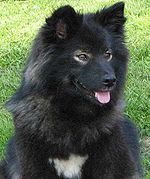
.
The profuse hair around the head and neck gives the distinct impression of a mane. Although the coat is profuse, it requires only a modest amount of maintenance.
A wide variety of colors are found in the breed. Any color is allowed in the breed standard, although a single color should predominate. Almost any color can be found: white, black, red, brown, sable and wolf-sable are frequently seen. One of the most common color combination's is black and tan: a predominantly black dog with tan legs and face.
Many Finnish Lapphunds have very distinctive facial markings. One of the unusual facial markings is "spectacles", where a ring of lighter colored hair around the eyes gives the impression that the dog is wearing spectacles. The spectacles of the Finnish Lapphund, while reminiscent of their cousins, the Keeshond
, are larger and more pronounced.
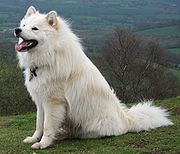 Like other spitz
Like other spitz
types, the tail is carried curving over the back. The Finnish Lapphund has a tail covered with profuse and long hair. The tail may hang whilst the dog stands.
, Europe
, Great Britain
, Australia
and the USA. The breed standards are mostly identical, with a few minor exceptions: in the English standard, the acceptance of tipped ears is omitted.
The breed is friendly and alert, and makes a good watch dog, due to its tendency to bark at unfamiliar things. The breed was originally used to herd reindeer by droving
, and barking helped it to be distinguished from wolves. Even when not herding, the Finnish Lapphund tends to bark with a purpose, and more rare cases of problem barking can normally be controlled by training.
The breed makes the ideal outdoor companion. It is active, cold-proof, and water-proof, and will gladly accompany people on walking or running trips. It is one of two breeds permitted to live outdoors in Finland.
Lappies are ideal choice for a family with small children. This is a very friendly breed and it normally avoids and flees from threatening situations. The breed is very curious, however, so some watching after them is necessary.
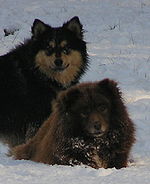 In Finland, at least two dogs have won national championships for obedience (Obedience Champion Hiidenparran Tielkka and Fin and Nordic Obedience Ch Kettuharjun Elle, both owned and trained by Rauno Nisula).
In Finland, at least two dogs have won national championships for obedience (Obedience Champion Hiidenparran Tielkka and Fin and Nordic Obedience Ch Kettuharjun Elle, both owned and trained by Rauno Nisula).
Finnish Lapphunds are also suitable for agility
. In the UK, Elbereth Taika has been awarded an agility warrant, and has represented England at the 2005 Kennel Club Nations cup, where she achieved a second place.
The breed adapts well to family life, including being responsive to children. Finnish Lapphunds have a gentle nature with children, people with disabilities, and the elderly.
trials, carting
, mushing
, obedience
, Rally obedience
, showmanship
, flyball
, tracking
, and herding
events. Herding
instincts and trainability can be measured at noncompetitive herding tests. Lapphunds exhibiting basic herding instincts can be trained to compete in herding trials.
Known medical issues include Generalised progressive retinal atrophy
(GPRA), hereditary cataracts.
. The Sami are an indigenous people residing in areas now divided between Finland, Sweden, Norway, and Russia. http://boreale.konto.itv.se/samieng.htm Traditionally, reindeer herding has been very important for the Sami people, and they are still involved in herding today. The Sami have used herding dogs for centuries, and these dogs were typically long in body, somewhat rectangular in shape, with long hair and a straight tail that would curl up over the back when the dog was moving. Finnish Lapphunds are the most similar to the long haired dogs developed by the Sami people in order to assist them with herding, often favored as winter herders for the reindeer. http://www.finnishlapphund.ca/node/5
Norwegians and Swedes were among the first to consider standardizing the dogs of Lapland prior to World War II.http://www.foresttrail.com/history.html In the post war years, the dogs of Lapland were at serious risk due to distemper outbreak. http://personal.inet.fi/yhdistry/lappalaiskoirat/english/finlapphund.html Swedish Lapphund breeders today believe that their breed, and other Lapphund breeds, were in serious danger of extinction. http://www.lapphund.se/lih09.htm A standard for the related Swedish Lapphund was adopted in 1944 in FCI (Federation Cynologique Internationale), and the Finnish Lapphund standard soon followed.
In Finland, the first breed standards were set in 1945 by the Finnish Kennel Club, who called the breed the Lappish Herder, also known as Kukonharjunlainen. It is believed that these dogs were the result of a cross between the Karelian Bear Dog
and the reindeer dogs, and had short hair. In the 1950s the Finnish Kennel Association (the second major kennel association in Finland) created the first breed standard for the Lapponian herder
. Acceptable colours for this breed were black, bear-brown and white.
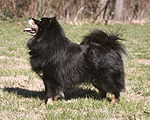 In the 1960s, the various Finnish kennel associations were unified, and in 1966 the breeds were reassessed. This resulted in the formal definition of two breeds: the Lapponian herder
In the 1960s, the various Finnish kennel associations were unified, and in 1966 the breeds were reassessed. This resulted in the formal definition of two breeds: the Lapponian herder
with a shorter coat was defined in 1966, and the longer coated Finnish Lapphund was defined in 1967.
At about the same time, technology enabled changes in the lifestyle of the Sami herders. Previously, the longer-haired dogs were generally preferred for herding, but with the advent of snowmobile
s, the preference started to change in favour of the shorter haired Lapponian herder. However, popularity did not die for the longer-haired breed, which was ranked the sixth most popular companion animal in Finland, ahead of the Finnish Spitz
(ranked ten), and the Karelian Bear Dog
(ranked 17). http://www.kennelliitto.fi/EN/kennelclub/kennelclub/htm
The first American litter was born in 1988. In 1994, the breed was recognised by the United Kennel Club
(UKC), the second largest kennel club in America, in the Northern Group. http://www.ukcdogs.com/Index.html The breed was accepted into the AKC Miscellaneous Group on July 1, 2009 with hopes of full breed recognition in 2011. The Finnish Lapphund Club of America (FLCA) is the parent organization in the United States.
The breed was first introduced to the United Kingdom
in 1989, and is represented by the Finnish Lapphund Club of Great Britain. It was introduced to Australia and Canada in 1995, and is accepted by the New Zealand Kennel Club and Canadian Kennel Club. In Canada, its parent club is the Finnish Lapphund Club of Canada.
Dog breed
Dog breeds are groups of closely related and visibly similar domestic dogs, which are all of the subspecies Canis lupus familiaris, having characteristic traits that are selected and maintained by humans, bred from a known foundation stock....
of Spitz
Spitz
Spitz-type dogs are a type of dog, characterized by long, thick, and often white fur, and pointed ears and muzzles...
type. Traditionally it has been used for herding reindeer
Reindeer
The reindeer , also known as the caribou in North America, is a deer from the Arctic and Subarctic, including both resident and migratory populations. While overall widespread and numerous, some of its subspecies are rare and one has already gone extinct.Reindeer vary considerably in color and size...
. Although it is one of the most popular dog breeds in its native country, Finland
Finland
Finland , officially the Republic of Finland, is a Nordic country situated in the Fennoscandian region of Northern Europe. It is bordered by Sweden in the west, Norway in the north and Russia in the east, while Estonia lies to its south across the Gulf of Finland.Around 5.4 million people reside...
, it is not very numerous outside of the Nordic countries
Nordic countries
The Nordic countries make up a region in Northern Europe and the North Atlantic which consists of Denmark, Finland, Iceland, Norway and Sweden and their associated territories, the Faroe Islands, Greenland and Åland...
.
Appearance

Type
The Finnish Lapphund is a medium sized, strongly built dog. It is slightly longer than it is high at the withersWithers
The withers is the ridge between the shoulder blades of a four-legged animal. In many species it is the tallest point of the body, and in horses and dogs it is the standard place to measure the animal's height .-Horses:The withers in horses are formed by the dorsal spinal processes of roughly the...
. It has a profuse coat with pricked, highly mobile ears.
It usually has long hair, and a bit of a long snout.
Size
The breed standard is 46 to 52 cm (18.1 to 20.5 in) at the withersWithers
The withers is the ridge between the shoulder blades of a four-legged animal. In many species it is the tallest point of the body, and in horses and dogs it is the standard place to measure the animal's height .-Horses:The withers in horses are formed by the dorsal spinal processes of roughly the...
for a male, and a slightly smaller 41 to 47 cm (16.1 to 18.5 in) for a female. However, some variation is allowed, since the breed standard states that the type is more important than the size.
A typical male of 49 cm height normally weighs 17 to 19 kg (37.5 to 41.9 lb), but the breed has a weight range of 15–24 kg 15 to 24 kg (33.1 to 52.9 lb), depending on size of the dog.

Coat
The Lapphund has a profuse double coat, with a short, fluffy undercoat and a longer, coarse topcoat. The coat makes the dog waterproof as well as resistant to extreme cold. In Finland, only two dog breeds are legally allowed to be kenneled outdoors in winter: the Finnish Lapphund and the Lapponian herderLapponian herder
The Lapponian herder is a breed of dog from Finland, one of three Lapphund breeds developed from a type of dog used by the Sami people for herding and guarding their reindeer....
.
The profuse hair around the head and neck gives the distinct impression of a mane. Although the coat is profuse, it requires only a modest amount of maintenance.
Color
The wide variety of colors and markings in Finnish Lapphunds.A wide variety of colors are found in the breed. Any color is allowed in the breed standard, although a single color should predominate. Almost any color can be found: white, black, red, brown, sable and wolf-sable are frequently seen. One of the most common color combination's is black and tan: a predominantly black dog with tan legs and face.
Many Finnish Lapphunds have very distinctive facial markings. One of the unusual facial markings is "spectacles", where a ring of lighter colored hair around the eyes gives the impression that the dog is wearing spectacles. The spectacles of the Finnish Lapphund, while reminiscent of their cousins, the Keeshond
Keeshond
The Keeshond is a medium-sized dog with a plush two-layer coat of silver and black fur with a 'ruff' and a curled tail. It originated in Germany, and its closest relatives are the other German spitzes such as the Pomeranian...
, are larger and more pronounced.
Tail

Spitz
Spitz-type dogs are a type of dog, characterized by long, thick, and often white fur, and pointed ears and muzzles...
types, the tail is carried curving over the back. The Finnish Lapphund has a tail covered with profuse and long hair. The tail may hang whilst the dog stands.
Differences in breed standard between countries
The Finnish Lapphund is a recognized breed in FinlandFinland
Finland , officially the Republic of Finland, is a Nordic country situated in the Fennoscandian region of Northern Europe. It is bordered by Sweden in the west, Norway in the north and Russia in the east, while Estonia lies to its south across the Gulf of Finland.Around 5.4 million people reside...
, Europe
Europe
Europe is, by convention, one of the world's seven continents. Comprising the westernmost peninsula of Eurasia, Europe is generally 'divided' from Asia to its east by the watershed divides of the Ural and Caucasus Mountains, the Ural River, the Caspian and Black Seas, and the waterways connecting...
, Great Britain
Great Britain
Great Britain or Britain is an island situated to the northwest of Continental Europe. It is the ninth largest island in the world, and the largest European island, as well as the largest of the British Isles...
, Australia
Australia
Australia , officially the Commonwealth of Australia, is a country in the Southern Hemisphere comprising the mainland of the Australian continent, the island of Tasmania, and numerous smaller islands in the Indian and Pacific Oceans. It is the world's sixth-largest country by total area...
and the USA. The breed standards are mostly identical, with a few minor exceptions: in the English standard, the acceptance of tipped ears is omitted.
Temperament
The Finnish Lapphund is a very intelligent and active breed. Finnish Lapphunds take well to training due to their intelligence. Some owners and fanciers claim that "Lappies" even have the ability to think through actions first. Although small in number worldwide, a noticeable number of Finnish Lapphunds have excelled in activities such as obedience trials, agility, herding trials, and pet therapy.The breed is friendly and alert, and makes a good watch dog, due to its tendency to bark at unfamiliar things. The breed was originally used to herd reindeer by droving
Droving
Droving is the practice of moving livestock over large distances by walking them "on the hoof".Droving stock to market, usually on foot and often with the aid of dogs, has a very long history in the old world...
, and barking helped it to be distinguished from wolves. Even when not herding, the Finnish Lapphund tends to bark with a purpose, and more rare cases of problem barking can normally be controlled by training.
The breed makes the ideal outdoor companion. It is active, cold-proof, and water-proof, and will gladly accompany people on walking or running trips. It is one of two breeds permitted to live outdoors in Finland.
Lappies are ideal choice for a family with small children. This is a very friendly breed and it normally avoids and flees from threatening situations. The breed is very curious, however, so some watching after them is necessary.

Finnish Lapphunds are also suitable for agility
Dog agility
Dog agility is a dog sport in which a handler directs a dog through an obstacle course in a race for both time and accuracy. Dogs run off-leash with no food or toys as incentives, and the handler can touch neither dog nor obstacles...
. In the UK, Elbereth Taika has been awarded an agility warrant, and has represented England at the 2005 Kennel Club Nations cup, where she achieved a second place.
The breed adapts well to family life, including being responsive to children. Finnish Lapphunds have a gentle nature with children, people with disabilities, and the elderly.
Activities
The Finnish Lapphund can compete in dog agilityDog agility
Dog agility is a dog sport in which a handler directs a dog through an obstacle course in a race for both time and accuracy. Dogs run off-leash with no food or toys as incentives, and the handler can touch neither dog nor obstacles...
trials, carting
Carting
Carting is a dog sport or activity in which a dog pulls a Dogcart filled with supplies, such as farm goods or firewood, but sometimes pulling people. Carting as a sport is also known as dryland mushing and is practiced all around the world, often to keep winter sled dogs in competition form during...
, mushing
Mushing
Mushing is a general term for a sport or transport method powered by dogs, and includes carting, pulka, scootering, sled dog racing, skijoring, freighting, and weight pulling. More specifically, it implies the use of one or more dogs to pull a sled on snow or a rig on dry land...
, obedience
Obedience training
Obedience training usually refers to the training of a dog and the term is most commonly used in that context. Obedience training ranges from very basic training, such as teaching the dog to reliably respond to basic commands such as "sit", "down", "come", and "stay", to high level competition...
, Rally obedience
Rally obedience
Rally obedience is a dog sport based on obedience. It was originally devised by Charles L. "Bud" Kramer from the obedience practice of "doodling" - doing a variety of interesting warmup and freestyle exercises....
, showmanship
Dog showmanship
Dog showmanship is a set of skills and etiquette used by handlers of dogs in a dog competition. Dog showmanship is not a competition in itself but a qualification of the handler to present a dog to its best advantage. Skills are technical as well as artistic...
, flyball
Flyball
Flyball is a dog sport in which teams of dogs race against each other from a start/finish line, over a line of hurdles, to a box that releases a tennis ball to be caught when the dog presses the spring-loaded pad, then back to their handlers while carrying the ball.Flyball is run in teams of four...
, tracking
Tracking (dog)
Tracking is a technique in which dogs are trained to locate certain objects, such as a downed bird, using the object's scent. Many bird and rabbit hunters train their dogs in tracking. The scent hounds are generally regarded as having the best tracking abilities among all dog breeds.In dog sports,...
, and herding
Herding
Herding is the act of bringing individual animals together into a group , maintaining the group and moving the group from place to place—or any combination of those. While the layperson uses the term "herding", most individuals involved in the process term it mustering, "working stock" or...
events. Herding
Herding
Herding is the act of bringing individual animals together into a group , maintaining the group and moving the group from place to place—or any combination of those. While the layperson uses the term "herding", most individuals involved in the process term it mustering, "working stock" or...
instincts and trainability can be measured at noncompetitive herding tests. Lapphunds exhibiting basic herding instincts can be trained to compete in herding trials.
Health
The Finnish Lapphund is a naturally healthy breed, and typically lives 12–14 years, although dogs of 16–17 years are not uncommon in Finland.Known medical issues include Generalised progressive retinal atrophy
Progressive retinal atrophy
Progressive retinal atrophy is a group of genetic diseases seen in certain breeds of dogs and, more rarely, cats. Similar to retinitis pigmentosa in humans, it is characterized by the bilateral degeneration of the retina, causing progressive vision loss culminating in blindness...
(GPRA), hereditary cataracts.
- GPRA is a progressive eye disease that can cause permanent blindness in dogs. In the Finnish Lapphund, this tends to be late onset, but can typically appear between the ages of 1 and 8 years. GPRA is a genetic illness, and is transmitted via an autosomal recessive geneGeneA gene is a molecular unit of heredity of a living organism. It is a name given to some stretches of DNA and RNA that code for a type of protein or for an RNA chain that has a function in the organism. Living beings depend on genes, as they specify all proteins and functional RNA chains...
. A reliable genetic test for the prcd-form of GRPA has been developed by OptiGen, and breeders are increasingly testing breeding animals before deciding on suitable mating pairs. The Finnish Lapphund club of Great Britain adopted an ethical policy in 2006 that matings will only be allowed if the progeny can not be affected by GPRA. In 2001, 2.5% dogs of Finnish dogs were affected by PRA.
- Some Lapphunds are affected by cataracts, with 3.4% of Finnish dogs affected. Cataracts can be caused by a number of factors, and the mode of inheritance is not yet well understood. Since the incidence in Finland is relatively high, the disease is considered to be hereditary. In the UK and USA the number of affected dogs is very small.
- The ethical standard in most countries require the stud dogs to be hip-scored, but the incidence of hip dysplasia is low.
Finland
The breed has its origins as a reindeer herder of the Sami peopleSami people
The Sami people, also spelled Sámi, or Saami, are the arctic indigenous people inhabiting Sápmi, which today encompasses parts of far northern Sweden, Norway, Finland, the Kola Peninsula of Russia, and the border area between south and middle Sweden and Norway. The Sámi are Europe’s northernmost...
. The Sami are an indigenous people residing in areas now divided between Finland, Sweden, Norway, and Russia. http://boreale.konto.itv.se/samieng.htm Traditionally, reindeer herding has been very important for the Sami people, and they are still involved in herding today. The Sami have used herding dogs for centuries, and these dogs were typically long in body, somewhat rectangular in shape, with long hair and a straight tail that would curl up over the back when the dog was moving. Finnish Lapphunds are the most similar to the long haired dogs developed by the Sami people in order to assist them with herding, often favored as winter herders for the reindeer. http://www.finnishlapphund.ca/node/5
Norwegians and Swedes were among the first to consider standardizing the dogs of Lapland prior to World War II.http://www.foresttrail.com/history.html In the post war years, the dogs of Lapland were at serious risk due to distemper outbreak. http://personal.inet.fi/yhdistry/lappalaiskoirat/english/finlapphund.html Swedish Lapphund breeders today believe that their breed, and other Lapphund breeds, were in serious danger of extinction. http://www.lapphund.se/lih09.htm A standard for the related Swedish Lapphund was adopted in 1944 in FCI (Federation Cynologique Internationale), and the Finnish Lapphund standard soon followed.
In Finland, the first breed standards were set in 1945 by the Finnish Kennel Club, who called the breed the Lappish Herder, also known as Kukonharjunlainen. It is believed that these dogs were the result of a cross between the Karelian Bear Dog
Karelian Bear Dog
The Karelian Bear Dog is a Finnish or Karelian breed of dog. In its home country, it is regarded as a national treasure. KBD will hunt any kind of animal. Its quick reflexes and fearless nature have made it very popular for hunting aggressive game, including bear, moose, and wild boar...
and the reindeer dogs, and had short hair. In the 1950s the Finnish Kennel Association (the second major kennel association in Finland) created the first breed standard for the Lapponian herder
Lapponian herder
The Lapponian herder is a breed of dog from Finland, one of three Lapphund breeds developed from a type of dog used by the Sami people for herding and guarding their reindeer....
. Acceptable colours for this breed were black, bear-brown and white.

Lapponian herder
The Lapponian herder is a breed of dog from Finland, one of three Lapphund breeds developed from a type of dog used by the Sami people for herding and guarding their reindeer....
with a shorter coat was defined in 1966, and the longer coated Finnish Lapphund was defined in 1967.
At about the same time, technology enabled changes in the lifestyle of the Sami herders. Previously, the longer-haired dogs were generally preferred for herding, but with the advent of snowmobile
Snowmobile
A snowmobile, also known in some places as a snowmachine, or sled,is a land vehicle for winter travel on snow. Designed to be operated on snow and ice, they require no road or trail. Design variations enable some machines to operate in deep snow or forests; most are used on open terrain, including...
s, the preference started to change in favour of the shorter haired Lapponian herder. However, popularity did not die for the longer-haired breed, which was ranked the sixth most popular companion animal in Finland, ahead of the Finnish Spitz
Finnish Spitz
A Finnish Spitz is a breed of dog originating in Finland. The breed was originally bred to hunt all types of game from squirrels and other rodents to bears. It is a "bark pointer", indicating the position of game by barking to attract the hunter's attention...
(ranked ten), and the Karelian Bear Dog
Karelian Bear Dog
The Karelian Bear Dog is a Finnish or Karelian breed of dog. In its home country, it is regarded as a national treasure. KBD will hunt any kind of animal. Its quick reflexes and fearless nature have made it very popular for hunting aggressive game, including bear, moose, and wild boar...
(ranked 17). http://www.kennelliitto.fi/EN/kennelclub/kennelclub/htm
The first American litter was born in 1988. In 1994, the breed was recognised by the United Kennel Club
United Kennel Club
The United Kennel Club is the second oldest all-breed registry of purebred dog pedigrees in the United States and the second largest in the world. According to the website, the club records 250,000 registrations annually. The UKC is not part of the International Canine Organisation, Fédération...
(UKC), the second largest kennel club in America, in the Northern Group. http://www.ukcdogs.com/Index.html The breed was accepted into the AKC Miscellaneous Group on July 1, 2009 with hopes of full breed recognition in 2011. The Finnish Lapphund Club of America (FLCA) is the parent organization in the United States.
The breed was first introduced to the United Kingdom
United Kingdom
The United Kingdom of Great Britain and Northern IrelandIn the United Kingdom and Dependencies, other languages have been officially recognised as legitimate autochthonous languages under the European Charter for Regional or Minority Languages...
in 1989, and is represented by the Finnish Lapphund Club of Great Britain. It was introduced to Australia and Canada in 1995, and is accepted by the New Zealand Kennel Club and Canadian Kennel Club. In Canada, its parent club is the Finnish Lapphund Club of Canada.

